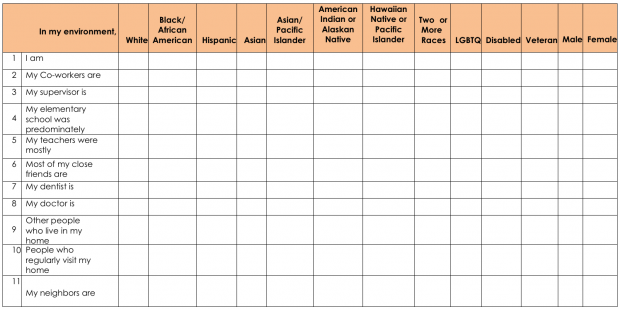I just got off the phone last week with someone who was struggling with incorporating diversity sourcing into the overall sourcing mix. A combination of being overwhelmed of where to start as well as selling it up to his superiors.
Yo, Sal, how come there ain’t no brothers on the wall?
In 1989, in Spike Lee’s movie Do the Right Thing, it was a character nicknamed Buggin’ Out who said, “Yo Sal! How come there ain’t no brothers on the wall?” While “Do the Right Thing” was considered a controversial movie at the time, it did get people to notice that true diversity was the exception rather than the rule.
Ask the average person if there is diversity in America and they will insist that yes, we are a great melting pot! Ask most people if they have a diverse workplace and the answer oftentimes in “No” and follow up with “it isn’t because if a diversity issue it’s because…” skill, the people who apply etc. You can fill in the rest.
Diversity is still a “touchy” subject. It bothers people; it’s the kind of conversation topic that gets executives to shush you with the words, “We don’t discuss stuff like that.”
The fact of the matter is, we must talk about it before industry as we know it crumbles. Look at the book “The World is Flat” by Thomas Friedman. In it, Thomas makes it clear that if we do not embrace diversity we will no longer be competitive. Incorporating diversity in to the sourcing mix is not only the right thing; it is one of the most important things a company can do to ensure growth and stability.
Where do I start?
You can’t change what you don’t acknowledge – Dr. Phil
Does your executive and HR team recognize that you are not in a diverse environment? A good place to start is to have a diversity audit. This may not be an “official” project and you might have to do this on your own time. Also, keep in mind that with a diversity audit, there can be:
- Negative attitudes
- Complacency
- Ignorance
- Resistance
- Fear of alienating the “majority”
- Term “diversity” indicates a minority agenda
- Fear of raising expectations
- Doing an audit indicates a willingness to make changes, so if workforce doesn’t want to, morale will suffer.
In any case, preparation and investigation are necessary before doing any project.
The diversity audit is a measuring tool that helps you take a snapshot of your organization’s service to diverse people as well as allows you to see where you are right now, set realistic, attainable goals for action, and then to identify and celebrate the progress made toward those goals. It also helps take a systematic snapshot of the entire system to ensure that your commitment to diversity in staffing and services is being met.
Your findings in the audit will aid in your selling of a diversity plan and will keep your organization accountable, give you real statistics and cause your organization to take a real hard look at what kind of environment it represents. Organize a team that can get the conversation started. This team should be made up of staff from all levels of the organization. The team will identify system goals, develop and deliver the audit, and then compile a summary of the findings. I found a great guide that you can use created by the College Committee for Diversity, Equity and Affirmative Action here. Below, you will see one example that is in their “Interactive Diversity Packet”.
Exercise #2: Diversity Profile
Directions: Put a check in all the appropriate boxes

Discussion points:
- This matrix can tell you a lot about your surroundings.
- Often, people find that their intercultural experiences are clustered; in the residence halls for instance. They often also are passive (one- way) and not interactive.
- Having this information on paper allows us to use them in new ways. Few other events force us to take stock of our multicultural interchanges.
- Most people don’t bring this information into their consciousness. They subconsciously are convinced that they are fairly multicultural. It can be jarring to discover how homogenous our environment is and our environment has had and continues to have an effect on our beliefs.
- This matrix can give us ideas about how we might enrich our cultural environment and how to reach out to and get to know people who belong to different groups (Joining a club or community group that includes different kinds of people is an example).
Diversity Sourcing Audit Project Plan (Sample)
Phase One
Is there Diversity-friendly branding, images, and communication resources readily available?
- Is there multilingual signage used in building?
- Does your company have any multicultural media on display?
- Do you have HR/Sourcing materials in languages other than English?
- Does your company have policies that support the Equality Act of 2010 that aims to protect disabled people and prevent disability discrimination? It provides legal rights for disabled people in the areas of:
- employment
- education
- access to goods, services and facilities including larger private clubs and land based transport services
- buying and renting land or property
- functions of public bodies, for example the issuing of licenses
- What forms & pamphlets do you have available in other languages?
- Are Adaptive / Assisting technologies available to employees?
- Assistive listening devices
- TTY
- Wheelchair accessible tables and computer workstations
- Are your signs appropriate size and color for people with limited vision?
Phase 2
- How many job postings have you offered in the last year targeting specific groups?
- How many community organizations do you partner with each year?
- In last year, were there collaborations on programs with community agencies serving diverse communities?
- How many of your employees speak a language other than English?
- Are community members who speak the diverse languages of your community aware of your jobs and where to find information about the openings?
- How many staff have attended cultural or diversity trainings in the last year?
- Have staff been encouraged to take foreign language courses?
- Do you offer additional pay for bilingual interactions with customers?
- Does your staff know how to reach an interpreter when needed?
This is one version of an auditing plan; Of course you will have to tweak this to fit your business needs. In any case, implementing a diversity plan is not only the “right thing” but it is a necessary “thing” that must happen if your company wants to thrive and grow.
Next week, I will introduce to you ways to sell it up the chain!
